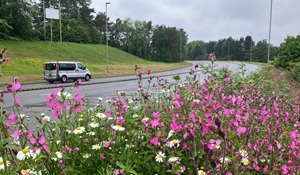Reducing mowing helps wildlife keep growing
Telford & Wrekin Council has added an extra 20,000 square metres (almost two full sized football pitches) of colourful wildflower areas since May, bringing the total of areas managed for wildflowers in the borough to 692,000m2 (equivalent to 64 football pitches).
Meadows, some verges and roundabouts throughout the borough have been left to grow, to create a greener and more attractive borough for residents. These areas are an ideal environment for butterflies, bees and other pollinating insects so provide an abundance of attractive wildflowers throughout the season.
Now the wildflower seeds are starting to drop as the flowers are turning to seed it is the ideal time for these areas to be mown, ensuring seeds are spread and sown ready for next year.
Councillor Carolyn Healy, Telford & Wrekin Council’s Cabinet Member for Neighbourhoods, Planning and Sustainability, said:
“Wildflower meadows with nectar-rich plants are vital habitats for a whole range of pollinators and other insects. On a single summer’s day, one acre of wildflower meadow can contain up to three million flowers, producing a kilogram of nectar, enough to support 96,000 honeybees per day.
“Our wildflower areas contain a wide range of native British wildflower species including Red Clover, Common Knapweed, Oxeye Daisy, Red Campion and Yellow Rattle, so we’ve been letting them grow since May to create vital habitats for a diverse range of wild pollinators and other plants.
“These wildflower areas have put on a wonderful display of colourful flowers over the summer but with most of them now starting to drop their seeds, we’re giving them a mow to make sure seeds are spread and sown so we can recreate these important habitats again next year and continue to make the borough a better place for wildlife as well as for residents.”

